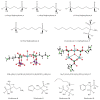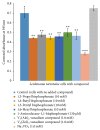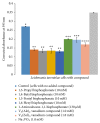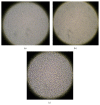Studies of the Effectiveness of Bisphosphonate and Vanadium-Bisphosphonate Compounds In Vitro against Axenic Leishmania tarentolae
- PMID: 27034744
- PMCID: PMC4789522
- DOI: 10.1155/2016/9025627
Studies of the Effectiveness of Bisphosphonate and Vanadium-Bisphosphonate Compounds In Vitro against Axenic Leishmania tarentolae
Abstract
Leishmaniasis is a disease that is a significant problem for people, especially in tropical regions of the world. Current drug therapies to treat the disease are expensive, not very effective, and/or of significant side effects. A series of alkyl bisphosphonate compounds and one amino bisphosphonate compound, as well as alendronate and zoledronate, were tested as potential agents against Leishmania tarentolae. Also, two polyoxometalates (POMs) with nitrogen-containing bisphosphonate ligands, vanadium/alendronate (V5(Ale)2) and vanadium/zoledronate (V3(Zol)3), were tested against L. tarentolae and compared to the results of the alendronate and zoledronate ligands alone. Of the compounds evaluated in this study, the V5(Ale)2 and V3(Zol)3 complexes were most effective in inhibiting the growth of L. tarentolae. The V5(Ale)2 complex had a larger impact on cell growth than either alendronate or orthovanadate alone, whereas zoledronate itself has a significant effect on cell growth, which may contribute to the activity of the V3(Zol)3 complex.
Figures









Similar articles
-
Inhibitory effects of decavanadate on several enzymes and Leishmania tarentolae in vitro.J Inorg Biochem. 2012 Mar;108:96-104. doi: 10.1016/j.jinorgbio.2011.09.009. Epub 2011 Sep 14. J Inorg Biochem. 2012. PMID: 22005446
-
Polyoxometalates functionalized by bisphosphonate ligands: synthesis, structural, magnetic, and spectroscopic characterizations and activity on tumor cell lines.Inorg Chem. 2012 Jul 16;51(14):7921-31. doi: 10.1021/ic3010079. Epub 2012 Jun 22. Inorg Chem. 2012. PMID: 22725619 Free PMC article.
-
Polyoxomolybdate Bisphosphonate Heterometallic Complexes: Synthesis, Structure, and Activity on a Breast Cancer Cell Line.Chemistry. 2015 Jul 13;21(29):10537-47. doi: 10.1002/chem.201406565. Epub 2015 Jun 15. Chemistry. 2015. PMID: 26076183
-
Leishmania spp.: proficiency of drug-resistant parasites.Int J Antimicrob Agents. 2007 Jun;29(6):637-42. doi: 10.1016/j.ijantimicag.2007.01.004. Epub 2007 Mar 13. Int J Antimicrob Agents. 2007. PMID: 17353113 Review.
-
Prospects for antimicrobial peptide-based immunotherapy approaches in Leishmania control.Expert Rev Anti Infect Ther. 2018 Jun;16(6):461-469. doi: 10.1080/14787210.2018.1483720. Epub 2018 Jun 12. Expert Rev Anti Infect Ther. 2018. PMID: 29889579 Review.
Cited by
-
Genotoxicity and acute and subchronic toxicity studies of a bioactive polyoxometalate in Wistar rats.BMC Pharmacol Toxicol. 2017 Apr 5;18(1):26. doi: 10.1186/s40360-017-0133-x. BMC Pharmacol Toxicol. 2017. PMID: 28381296 Free PMC article.
-
Unravelling the myth surrounding sterol biosynthesis as plausible target for drug design against leishmaniasis.J Parasit Dis. 2021 Dec;45(4):1152-1171. doi: 10.1007/s12639-021-01390-1. Epub 2021 Apr 24. J Parasit Dis. 2021. PMID: 34790000 Free PMC article. Review.
-
Critical Insight into Plausible Acquired Tocopherol Pathway in Neglected Human Trypanosomatids.ACS Omega. 2021 Nov 16;6(47):31396-31403. doi: 10.1021/acsomega.1c05046. eCollection 2021 Nov 30. ACS Omega. 2021. PMID: 34869966 Free PMC article. Review.
-
Synthesis and Leishmanicidal Activity of Novel Urea, Thiourea, and Selenourea Derivatives of Diselenides.Antimicrob Agents Chemother. 2019 Apr 25;63(5):e02200-18. doi: 10.1128/AAC.02200-18. Print 2019 May. Antimicrob Agents Chemother. 2019. PMID: 30782984 Free PMC article.
-
Evidence That Speciation of Oxovanadium Complexes Does Not Solely Account for Inhibition of Leishmania Acid Phosphatases.Front Chem. 2018 Apr 12;6:109. doi: 10.3389/fchem.2018.00109. eCollection 2018. Front Chem. 2018. PMID: 29707535 Free PMC article.
References
-
- June 2011, http://www.who.int/leishmaniasis/en/
-
- January 2011, http://www.cdc.gov/parasites/leishmaniasis/
MeSH terms
Substances
LinkOut - more resources
Full Text Sources
Other Literature Sources

